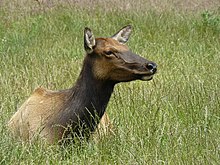| Roosevelt Elk | |
|---|---|

| |
| Male (bull) at Northwest Trek, Washington, US | |

| |
| Female (cow) at Prairie Creek Redwoods State Park, California, US | |
| Scientific classification | |
| Domain: | Eukaryota |
| Kingdom: | Animalia |
| Phylum: | Chordata |
| Class: | Mammalia |
| Order: | Artiodactyla |
| Family: | Cervidae |
| Genus: | Cervus |
| Species: | |
| Subspecies: | C. c. roosevelti
|
| Trinomial name | |
| Cervus canadensis roosevelti Merriam, 1897
| |
| Synonyms | |
|
Cervus elaphus roosevelti | |
The Roosevelt elk (Cervus canadensis roosevelti), also known commonly as the Olympic elk and Roosevelt's wapiti, is the largest of the four surviving subspecies of elk (Cervus canadensis) in North America by body mass.[2] Mature bulls weigh from 700 to 1,200 lb (320 to 540 kg). with very rare large bulls weighing more.[3] Its geographic range includes temperate rainforests of the Pacific Northwest including parts of northern California. It was introduced to Alaska's Afognak, Kodiak, and Raspberry Islands in 1928[4][5][6] and reintroduced to British Columbia's Sunshine Coast from Vancouver Island in 1986.[4]
- ^ "Cervus elaphus roosevelti". NatureServe Explorer. 2 August 2024. Retrieved 7 September 2024.
- ^ Cite error: The named reference
TUGtEHwas invoked but never defined (see the help page). - ^ Dr. Mike Jenkins, 2005
- ^ a b "Guided Roosevelt Elk Hunting in BC". Coastal Inlet Adventures. 17 December 2019. Retrieved 26 July 2021.
- ^ Nancy Gates, ed. (November 2006). The Alaska Almanac: Facts about Alaska 30th Anniversary Edition. Alaska Northwest Books. ISBN 0-88240-652-3.
- ^ Rennick, Penny (November 1996). Mammals of Alaska. Alaska Geographic Society. ISBN 1-56661-034-6.
